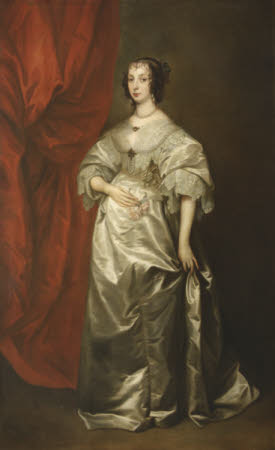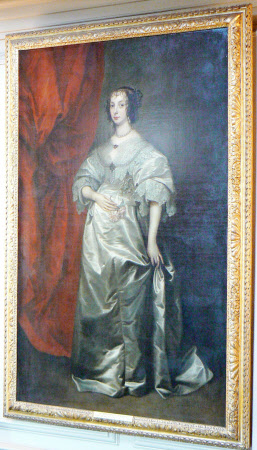The Hon. Catherine Vere, Mrs Oliver St. John, later Lady Poulett (c.1612/13 – between 1648 and 1653)
after Sir Anthony Van Dyck (Antwerp 1599 - London 1641)
Category
Art / Oil paintings
Date
1675 - 1699
Materials
Oil on canvas
Measurements
2083 x 1295 mm (82 x 51 in)
Order this imageCollection
Ham House, Surrey
NT 1139645
Summary
Oil painting on canvas, The Hon. Catherine Vere, Mrs Oliver St. John, later Lady Poulett (c.1612/13 – between 1648 and 1653), after Sir Anthony Van Dyck (Antwerp 1599 - London 1641), 1675-1699. A full-length portrait of a young woman standing, turned slightly to the left, gazing at the spectator, in a silver gown, with lace collar and cuffs, holding her belly with her right hand (in token of pregnancy), her left hand by her side, holding a fold in her dress, large scarlet drape on the left. The original which was presumably painted for the sitter or her first husband, and later in the house of her second husband, Hinton St. George, whence it was plundered in the Civil War was acquired by the 3rd Earl of Lothian, by whom it was presented to the 1st Earl of Clarendon in 1667. In the part of that collection that descended via Catherine, Duchess of Queensberry to the 13th Earl of Home; his sale, Christie’s, 20th June 1919; then, after passing through various hands, to the son of Anthony and Elizabeth Sheldon, King’s Manor, Isle of Wight. She was the Third daughter and coheiress of Horace, Lord Vere of Tilbury; married first in March 1633/4, Oliver St. John, son and heir of Sir John St. John, 1st Bt., who died in November 1640. Their only son, John, succeeded his grandfather as 2nd Bart. but died without issue; secondly, in March 1640/1, as his first wife, the Hon. John Poulett (c.1615-1655), later 2nd Baron Poulett (succ. March 1648/9). Their eldest son, John (b. c. 1642) became 3rd Baron. She was still alive in March 1648, but must have died by January 1653, when her widower married his second wife, Anne Browne.
Provenance
In catalogue of about 1820 (although omitted by Walpole in 1770, probably there); acquired in 1948 by HM Government when Sir Lyonel, 4th Bt (1854 – 1952) and Sir Cecil Tollemache, 5th Bt (1886 – 1969) presented Ham House to the National Trust, and entrusted to the care of the Victoria & Albert Museum, until 1990, when returned to the care of the National Trust, and to which ownership was transferred in 2002
Credit line
Ham House, The Dysart Collection (purchased by HM Government in 1948 and transferred to the National Trust in 2002)
Marks and inscriptions
Verso: on a printed label: SIR L. TOLLEMACHE / NO2 Verso: on a blue-bordered luggage label: B 1650
Makers and roles
after Sir Anthony Van Dyck (Antwerp 1599 - London 1641), artist

